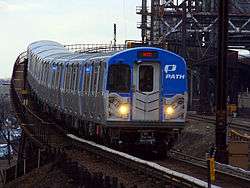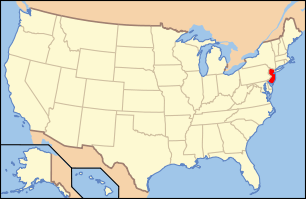Pennsylvania Station (Newark)
Newark Penn Station | |||||||||||||||||||||||||||||||||||||||||||||||||||||||||||||||||||||||||||||||||||||||||||||||||||||
|---|---|---|---|---|---|---|---|---|---|---|---|---|---|---|---|---|---|---|---|---|---|---|---|---|---|---|---|---|---|---|---|---|---|---|---|---|---|---|---|---|---|---|---|---|---|---|---|---|---|---|---|---|---|---|---|---|---|---|---|---|---|---|---|---|---|---|---|---|---|---|---|---|---|---|---|---|---|---|---|---|---|---|---|---|---|---|---|---|---|---|---|---|---|---|---|---|---|---|---|---|---|
 Penn Station main entrance at dusk | |||||||||||||||||||||||||||||||||||||||||||||||||||||||||||||||||||||||||||||||||||||||||||||||||||||
| Location |
Raymond Plaza West and Market Street Newark, NJ 07102 | ||||||||||||||||||||||||||||||||||||||||||||||||||||||||||||||||||||||||||||||||||||||||||||||||||||
| Owned by | NJ Transit | ||||||||||||||||||||||||||||||||||||||||||||||||||||||||||||||||||||||||||||||||||||||||||||||||||||
| Line(s) |
Northeast Corridor | ||||||||||||||||||||||||||||||||||||||||||||||||||||||||||||||||||||||||||||||||||||||||||||||||||||
| Platforms |
1 side platform (upper level) 3 island platforms and 2 side platforms (main level) | ||||||||||||||||||||||||||||||||||||||||||||||||||||||||||||||||||||||||||||||||||||||||||||||||||||
| Tracks | 6 (Northeast Corridor), 2 (PATH) | ||||||||||||||||||||||||||||||||||||||||||||||||||||||||||||||||||||||||||||||||||||||||||||||||||||
| Connections |
| ||||||||||||||||||||||||||||||||||||||||||||||||||||||||||||||||||||||||||||||||||||||||||||||||||||
| Construction | |||||||||||||||||||||||||||||||||||||||||||||||||||||||||||||||||||||||||||||||||||||||||||||||||||||
| Parking | Available in immediate area | ||||||||||||||||||||||||||||||||||||||||||||||||||||||||||||||||||||||||||||||||||||||||||||||||||||
| Bicycle facilities | No | ||||||||||||||||||||||||||||||||||||||||||||||||||||||||||||||||||||||||||||||||||||||||||||||||||||
| Disabled access | Yes | ||||||||||||||||||||||||||||||||||||||||||||||||||||||||||||||||||||||||||||||||||||||||||||||||||||
| Other information | |||||||||||||||||||||||||||||||||||||||||||||||||||||||||||||||||||||||||||||||||||||||||||||||||||||
| Station code |
NWK (Amtrak) ZRP (IATA) | ||||||||||||||||||||||||||||||||||||||||||||||||||||||||||||||||||||||||||||||||||||||||||||||||||||
| Fare zone | 1 (NJT only) | ||||||||||||||||||||||||||||||||||||||||||||||||||||||||||||||||||||||||||||||||||||||||||||||||||||
| History | |||||||||||||||||||||||||||||||||||||||||||||||||||||||||||||||||||||||||||||||||||||||||||||||||||||
| Opened | March 24, 1935 | ||||||||||||||||||||||||||||||||||||||||||||||||||||||||||||||||||||||||||||||||||||||||||||||||||||
| Rebuilt | 2007 | ||||||||||||||||||||||||||||||||||||||||||||||||||||||||||||||||||||||||||||||||||||||||||||||||||||
| Electrified |
12 kV 25 Hz AC overhead lines (Northeast Corridor) 600 V DC third rail (PATH) 750 V DC overhead lines (NLR) | ||||||||||||||||||||||||||||||||||||||||||||||||||||||||||||||||||||||||||||||||||||||||||||||||||||
| Traffic | |||||||||||||||||||||||||||||||||||||||||||||||||||||||||||||||||||||||||||||||||||||||||||||||||||||
| Passengers (2017) | 27,695 (average weekday)[1][2] (NJT) | ||||||||||||||||||||||||||||||||||||||||||||||||||||||||||||||||||||||||||||||||||||||||||||||||||||
| Passengers (2017) |
682,020[3] | ||||||||||||||||||||||||||||||||||||||||||||||||||||||||||||||||||||||||||||||||||||||||||||||||||||
| Passengers (2017) |
8,918,157[4] | ||||||||||||||||||||||||||||||||||||||||||||||||||||||||||||||||||||||||||||||||||||||||||||||||||||
| Services | |||||||||||||||||||||||||||||||||||||||||||||||||||||||||||||||||||||||||||||||||||||||||||||||||||||
| |||||||||||||||||||||||||||||||||||||||||||||||||||||||||||||||||||||||||||||||||||||||||||||||||||||
| |||||||||||||||||||||||||||||||||||||||||||||||||||||||||||||||||||||||||||||||||||||||||||||||||||||
|
Pennsylvania Station | |||||||||||||||||||||||||||||||||||||||||||||||||||||||||||||||||||||||||||||||||||||||||||||||||||||
 Newark Penn Station | |||||||||||||||||||||||||||||||||||||||||||||||||||||||||||||||||||||||||||||||||||||||||||||||||||||
| Location |
Raymond Plaza West, Newark, New Jersey | ||||||||||||||||||||||||||||||||||||||||||||||||||||||||||||||||||||||||||||||||||||||||||||||||||||
| Coordinates | 40°44′5″N 74°9′51″W / 40.73472°N 74.16417°WCoordinates: 40°44′5″N 74°9′51″W / 40.73472°N 74.16417°W | ||||||||||||||||||||||||||||||||||||||||||||||||||||||||||||||||||||||||||||||||||||||||||||||||||||
| Area | 5 acres (2 ha) | ||||||||||||||||||||||||||||||||||||||||||||||||||||||||||||||||||||||||||||||||||||||||||||||||||||
| Built | 1935 | ||||||||||||||||||||||||||||||||||||||||||||||||||||||||||||||||||||||||||||||||||||||||||||||||||||
| Architect | McKim, Mead & White | ||||||||||||||||||||||||||||||||||||||||||||||||||||||||||||||||||||||||||||||||||||||||||||||||||||
| Architectural style | Classical Revival, Art Deco | ||||||||||||||||||||||||||||||||||||||||||||||||||||||||||||||||||||||||||||||||||||||||||||||||||||
| NRHP reference # | 78001760[5] | ||||||||||||||||||||||||||||||||||||||||||||||||||||||||||||||||||||||||||||||||||||||||||||||||||||
| Added to NRHP | December 20, 1978 | ||||||||||||||||||||||||||||||||||||||||||||||||||||||||||||||||||||||||||||||||||||||||||||||||||||
Pennsylvania Station (also known as Newark Penn Station) is an intermodal passenger station in Newark, New Jersey.[6] Located at Raymond Plaza, between Market Street and Raymond Boulevard, Newark Penn Station is served by multiple rail and bus carriers, making it one of the major transportation hubs for the New York metropolitan area. It is served by Newark Light Rail,[7] three NJ Transit commuter rail lines, the PATH rapid transit system, and all 11 of Amtrak's Northeast Corridor services (including the Acela Express). The station is also served by intercity bus carriers Greyhound, Peter Pan, and Trailways, as well as 33 local and regional bus lines operated by NJ Transit Bus Operations and ONE Bus (Orange-Newark-Elizabeth).
History
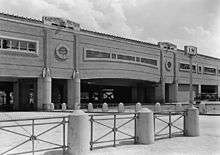
.jpg)
Designed by the renowned architectural firm McKim, Mead & White, the station contains a mixture of Art Deco and Neo-Classical features. The interior of the main waiting room has medallions illustrating the history of transportation, from wagons to steamships to cars and airplanes, the eventual doom of the railroad age. The current building was dedicated on March 23, 1935; the first regular train to use it was a New York–Philadelphia express at 10:17 on March 24.[8][9] The new station was built alongside (northwest of) the old station, which was then demolished and replaced by the southeast half of the present station, completed in 1937. Except for the separate, underground Newark Light Rail station (formerly the Newark City Subway), tracks are elevated above street level.
It was built to be one of the centerpieces of the former Pennsylvania Railroad's (PRR's) train network, and to become a transfer point to the Hudson and Manhattan Railroad (now PATH), which was partially funded by the PRR, for travel to lower Manhattan. At the time, PRR operated 232 weekday trains (total of both directions) between Newark and New York Penn Station; after 1937, the 10-mile trip took an average of 16 minutes.
.jpg)
The station, the adjacent 230-foot Dock Bridge over the Passaic River (the longest three-track railway lift span in existence at the time), the Newark City Subway extension and the realignment of the H&M cost $42 million, borne almost evenly by the PRR and the City of Newark. Both systems were extended or realigned to the station on June 20, 1937, and the nearby Manhattan Transfer station was closed.[10]
The Port of New York Authority (now the Port Authority of New York and New Jersey) bought the bankrupt H&M Railroad and reorganized it as Port Authority Trans-Hudson in 1962. New Jersey Department of Transportation's Aldene Plan redirected Central Railroad of New Jersey and Reading Railroad trains from Communipaw Terminal in Jersey City to Newark Penn Station in 1967. The Pennsylvania Railroad merged with longtime rival New York Central Railroad in 1968 to form Penn Central Railroad, but Newark kept the name "Penn Station." Amtrak took over inter-city service in 1971, but Penn Central continued to operate commuter service, despite suffering from major bankruptcy. In 1976, the New Jersey Department of Transportation acquired Penn Central, Reading and Jersey Central passenger service, which included lines from as far away as Philadelphia's SEPTA diesel service along the West Trenton Line, with Conrail operating service under contract. New Jersey Transit acquired the rail line north of West Trenton in 1982, and established their rail operations division in 1983, acquiring almost all commuter rail service from Conrail within the state.
Newark Penn Station was extensively renovated in 2007, with restoration of the facade and historic interior materials (e.g., plaster ceilings, marble and limestone, windows, lighting fixtures), as well as train platform and equipment improvements.[11]
Current operations
Despite being 10 mi (16 km) from New York Penn, the busiest train station in North America, Newark Penn is a major station in its own right. In 2014 it was the 14th busiest station in the Amtrak system. It is served by all 11 services running along the Northeast Corridor.
Three New Jersey Transit commuter rail lines converge here: the Northeast Corridor Line which continues into New York, the North Jersey Coast Line which continues to New York or Hoboken, and the Raritan Valley Line, which generally terminates here, with the exception of select trains that continue on and terminate at New York Penn Station, and one morning train continuing to Hoboken.
It is the western terminus of the Newark–World Trade Center line of the PATH train, operated by the Port Authority of New York and New Jersey. Trains terminate on the upper level and return to service on the lower level.
On the lower level is the south end of the Newark Light Rail. Passengers on this light rail system from Newark and its nearby suburbs can transfer to Amtrak or PATH trains, or travel to Newark Broad Street or downtown Newark.
Newark Penn Station carries the IATA airport code of ZRP.[12]
Tracks and platforms
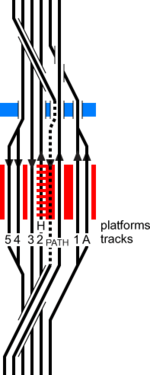
Newark Penn has eight tracks (not including Newark Light Rail). Seven are on one level, but PATH trains arrive on an upper-level track with a platform on the west side, from which passengers can quickly reach platforms for their onward trains.[13]
- Track A is less used and has a side platform, usually for Raritan Valley Line arrivals. Trains relay and lay-up at Hudson Yard in Harrison before returning on Track 5 for the reverse trip. Occasionally used by Amtrak trains to New York Penn Station.
- Track 1 is normally used by New Jersey Transit trains to New York Penn Station and is served by an island platform shared with Track M.
- Track M is the track for departing PATH trains to World Trade Center in Lower Manhattan.[13]
- Track 2 is typically used by northbound Amtrak and New Jersey Transit express trains, but is also used during the PM rush for westbound North Jersey Coast Line express trains. This track has an island platform that is shared with track M.
- Track 3 is usually used by southbound Amtrak trains, though westbound New Jersey Transit Northeast Corridor Line express trains will often use this track in the evening rush hours. This platform has an island platform shared with track 4.
- Track 4 is normally used by westbound New Jersey Transit trains traveling via Rahway.
- Track 5 is usually used by westbound Raritan Valley Line trains and weekend eastbound Raritan Valley Line trains terminating. This track has a side platform.
- Track H is for discharging PATH trains. This upper-level track, which did not have turnstiles until SmartLink ones were installed in 2005, has stairs to Track 2, along with ramps to Tracks 3 and 4, and a separate stairway to Track 5. Trains relay and lay-up south of the station before returning on Track M for the trip to World Trade Center. There are two pairs of crossover switches south of the station for that purpose, as well as a center express track from which trains can be reversed quickly.[13]
As part of the 10 year capital improvement program, Platform H will undergo an expensive renovation which includes the modification of the existing platforms, stairwells to track 2 and renovation of the 1935 original tan brick walls. Construction is expected to begin in late March 2018.
Platform layout
Note: Shows platform layouts only, not the actual station layout.
Gallery
 Main entrance at night
Main entrance at night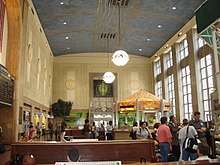 Interior of main waiting room, featuring an information booth
Interior of main waiting room, featuring an information booth- Light rail platform
 PATH PA-5 train arriving on upper level
PATH PA-5 train arriving on upper level PATH platform
PATH platform Pedestrian ramp
Pedestrian ramp
Surrounding area
- Federal Bureau of Investigation New Jersey Regional Headquarters
- Former Newark and New York Railroad Lafayette Street terminal
- Ironbound
- Military Park
- Newark Municipal Court
- New Jersey Performing Arts Center
- Site of Park Place (H&M station)
- Prudential Center
- Riverbank Park
- Seton Hall University School of Law
In popular culture
- The station was featured in several scenes of the 1980 film Gloria.
- The station is represented in the 2010 Fringe episode "Entrada" by a visually similar transportation hub in Vancouver, British Columbia. In the alternate universe depicted in the series it is named Springsteen Station after locally born musician Bruce Springsteen. The station is represented a second time in 2012 in the Season 5 episode "The Bullet That Saved the World" where the 2036 version of the station serves as a military checkpoint into an occupied Manhattan for high-speed rail traffic.
- The station is also mentioned in Glenn Miller's iconic hit, "Chattanooga Choo Choo."
Sources and notes
- ↑ "QUARTERLY RIDERSHIP TRENDS ANALYSIS" (PDF). New Jersey Transit. Archived from the original (PDF) on December 27, 2012. Retrieved January 4, 2013.
- ↑ "How Many Riders Use NJ Transit's Hoboken Train Station?". Hoboken Patch. Retrieved 2018-07-18.
- ↑ "Amtrak Fact Sheet, FY2017, State of New Jersey" (PDF). Amtrak. November 2017. Retrieved 26 December 2017.
- ↑ "PATH Ridership Report" (PDF). pathnynj.gov. Port Authority of New York and New Jersey. 2017. Retrieved January 28, 2018.
- ↑ National Park Service (2010-07-09). "National Register Information System". National Register of Historic Places. National Park Service.
- ↑ "Getting Around". Greater Newark Convention & Visitors Bureau. Retrieved 2010-03-13.
- ↑ Pirmann, David; Darlington, Peggy. "Newark City Subway". nycsubway.org. Retrieved 2010-03-13.
- ↑ "Newark Dedicates New Station Today". The New York Times. March 23, 1935. p. 13. Retrieved 2010-05-30.
- ↑ "Newark Dedicates Its New Terminal". The New York Times. March 24, 1935. p. N1. Retrieved 2010-05-30.
- ↑ "New Station Open for Hudson Tubes". The New York Times. June 20, 1937. p. 1. Retrieved 2010-05-30.
- ↑ Hall Construction Co., Howell, NJ. "NJ Transit - Newark Penn Station Improvement Program." Accessed 2011-11-15.
- ↑ "Three Letter Airport Codes". Lastupdate Travel. Retrieved 2010-03-13.
- 1 2 3 Dougherty, Peter (2006) [2002]. Tracks of the New York City Subway 2006 (3rd ed.). Dougherty. OCLC 49777633 – via Google Books.
External links
| Wikimedia Commons has media related to Newark Penn Station. |
|
| |
|
| |
|
| |
|
|
- NJT rail station information page for Pennsylvania Station (Newark)
- DepartureVision real time train information for Pennsylvania Station (Newark)
- NJT Newark Light Rail station information page for Pennsylvania Station (Newark)
